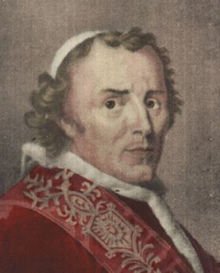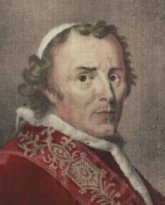- Home
- Resurrection ▾
-
Learn ▾
- Free library
- Glossary
- Documents
- Initiation
-
Shaped fabrics
- Introduction
- Popularization
- Definitions
- Le métier de façonné
- Principes du façonné
- Mécaniques de façonné
- Le jeu des crochets
- Les cartons
- Chaîne des cartons
- Mécanique 104 en détail
- Pour en finir
- Montage façonné
- Empoutage 1/3
- Empoutage 2/3
- Empoutage 3/3
- Punching, hanging and dip
- Autres façonnés
- Façonnés et Islam
-
Cours de tissage 1912
- Bâti d'un métier
- Le rouleau arrière
- Les bascules
- Formation du pas
- Position de organes
- Mécanique 104 Jacquard
- Fonctionnement 104
- Lisage des cartons
- Le battant du métier
- Le régulateur
- Réduction et régulateur
- Mise au métier d'une chaîne
- Mise en route du métier
- Navettes à soie
- Battage
- Ourdissage mécanique
- Préparation chaînes et trames
- Equipment ▾
- Chronicles ▾
- Fabrics ▾
- Techniques ▾
- Culture ▾
- Language ▾
Portrait of Pope Pius VII in velvet Gregory
The work of Henri Algoud (1908), Gaspard Grégoire and its Velours d'Art describes in 72 pages the history of Gaspard Grégoire and its process of velvet weaving.
To our knowledge, this is the only work dealing with this subject.
Gaspard Gregoire, unable to succeed in weaving his velvets in greater breadth, as his creditors demanded, in the person of the Count d'Angiviller, fell into disgrace and then into total oblivion.
After him, several imitators, such as the Herguez, Garin, Henry, and Martin in 1894, attempted to reproduce his technique, but none ever succeeded in matching it.
Later, interesting imitations were obtained by printing on a chain, however, the engraved plate, however skilfully combined and applied it may be, can not give the fineness of Grégoire's brush, its half-tints, its shadows, Fonfus, its contours supple, softened, loose.
These are not Grégoire velvet ...

Grégoire Velvet
Here we want to talk about the unique and intriguing specimens that are Grégoire velvet.
Gaspard Grégoire was born in Aix en Provence on 20 October 1751 and died on 12 May 1846.

He belonged to a family of silk merchants. The silkworm had long been erected in Aix, but silk was also made. At the age of 26, working in paternal commerce, he had the idea of his painted velvets and undertook his attempts to realize his invention.
It required a considerable amount of study, research, time spent, and expenditure of money in order to carry out his first works, which excited the astonishment and admiration of all those who saw them at Aix.Then, full of hope and confidence in the future of his discovery, he sought to derive glory and profit from it and decided to go to Paris to present his invention to numerous, rich and influential amateurs and obtain privileges .
He succeeded in presenting the first attempts of his velvets, still imperfect, to the high official who then directed the Department of Arts of the Kingdom, Count d'Angiviller.He received encouragement and material assistance. He was even lodged at the Galeries du Louvre.
It is important, before continuing this little narrative, to describe a little what its famous fabrics were.We must first explain that we do not know the details of Gregory's techniques. Indeed, we know from a letter from a niece of Gaspard Grégoire that a few days before his death, his story had gone badly, as we shall see later, the latter had burned all the papers concerning his The invention of velvet.
However, it seems certain that there is no mysterious technique there, but merely the fruit of an ingenious turn of the hand, a know-how and a dexterity acquired through incessant efforts, laborious work and furious pugnacity . "A hundred times on the loom, put back the work, polish it, and repolve it again ...".
The velvets of Grégoire reproduce to perfection portraits such as those of Napoleon, Pope Pius VII, Louis XVIII or the Duchess of Angoulème, reproductions of famous works of Raphael, Greuze, flowers ... The Historical Museum of Tissues Of Lyon presents numerous Grégoire velvet.
Grégoire velvet never exceeded 27 cm x 30 cm, at least for those who were successful, for he was often subjected for a long time to the pressure exerted, as will be seen later, by the Count d'Angiviller, his creditor Of the state, to realize its velvets in wide width, that is to say around 50 cm.
We have just said that the velvet Gregory represented very detailed drawings like portraits. Grégoire's extraordinary technique is due to the fact that these drawings are not shaped (as they would be with a pickpocket, for we must not forget that Jacquard's mechanics did not yet exist) Nor printed as they might have been on the plain fabric after weaving. Gregory painted his portraits on the chain before the weaving. To understand a little better Grégoire's prowess, let us say two words of the description of a velvet.
The plain velvet is made up of at least two chains, one of which, called the bottom chain, is used to weave normally according to a simple weave (like taffeta), the body of the fabric.The second chain, known as the hair chain, only concurs with the production of the design, materialized by tufts of hair, and not concerned with the bottom of the fabric.These two chains are plotted on two different rolls for the following reason: The bottom of the fabric, in taffeta or satin, consumes a certain amount of warp thread in a meter of length; Let us say, for example, that for a meter of velvet, it is necessary to count 1.10 m of length of the chain of bottom (10% of stirring). The velvet drawing consumes, for the same length of fabric, infinitely more chain, for the simple reason of its path around the irons which make it possible to create loops which will be cut in two to form the tufts of hair. This length consumed varies, of course depending on the height of the velvet bristles, and therefore on the height of the irons to be cut. On average, to weave a meter of fabric, it will take 7 meters of hair (perhaps less for Grégoire velvet, the latter limiting the height of the hair using low cutting irons).
It is understood that the two chains, per 1 meter of fabric, having to provide 1.10 m for the bottom and 7 m for the coat must imperatively be placed on two different rollers, the bottom roller and the roll of hair. But this little explanation makes us understand all the difficulty of Gregory's work:
Indeed, since for 1 cm of drawing made by the hair, it is necessary to consume 7 cm of this pile yarn, it is realized that the pattern painted on the hair chain before weaving will have to undergo a deformation of a ratio of 1 to 7 for Regain a normal proportion during weaving. This is fairly easy to envisage for a simple or abstract motif, but what can one say when it comes to representing very faithfully the portrait of the Emperor? ? ?
Look now below the porch of Pope Pius VII that he represented.